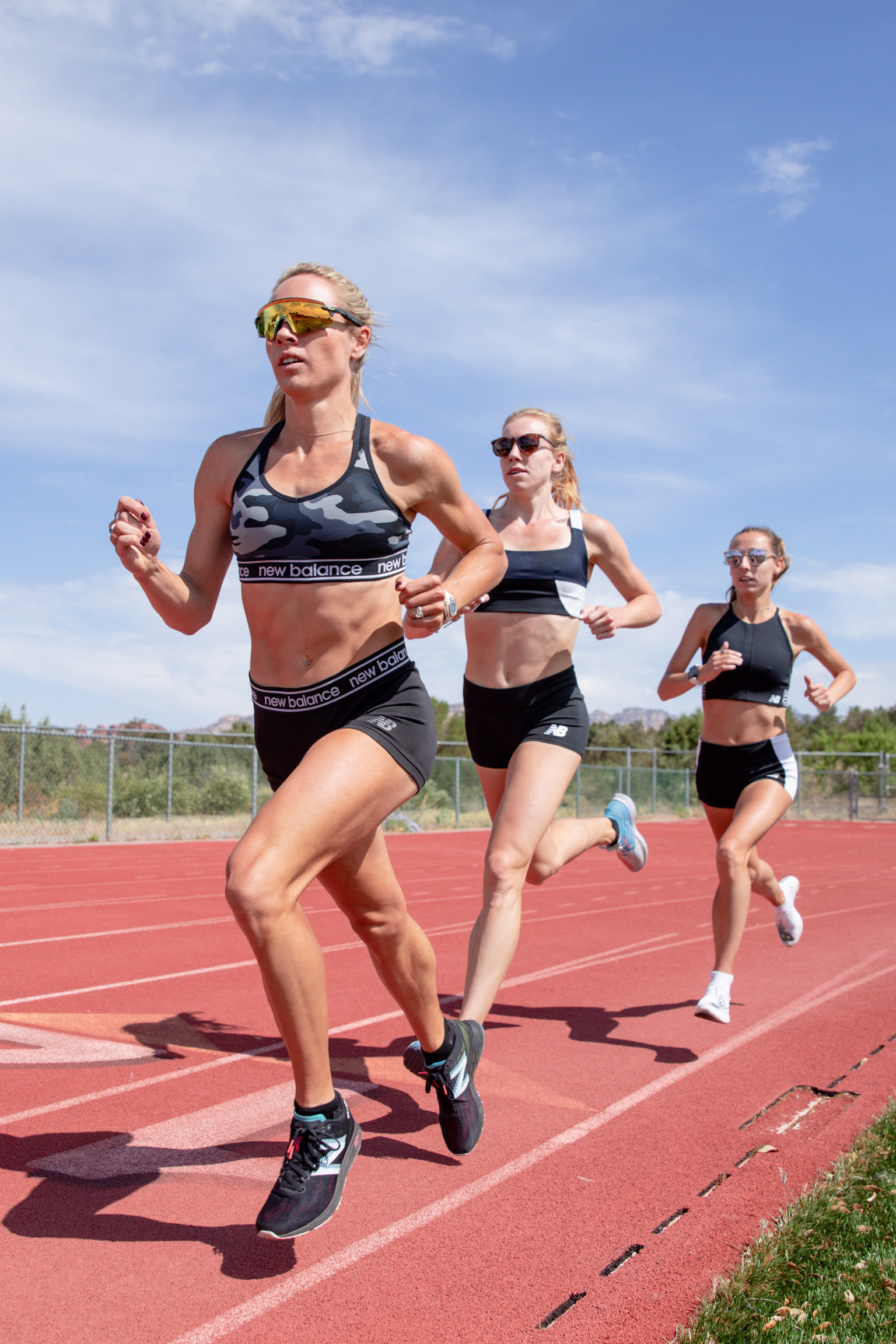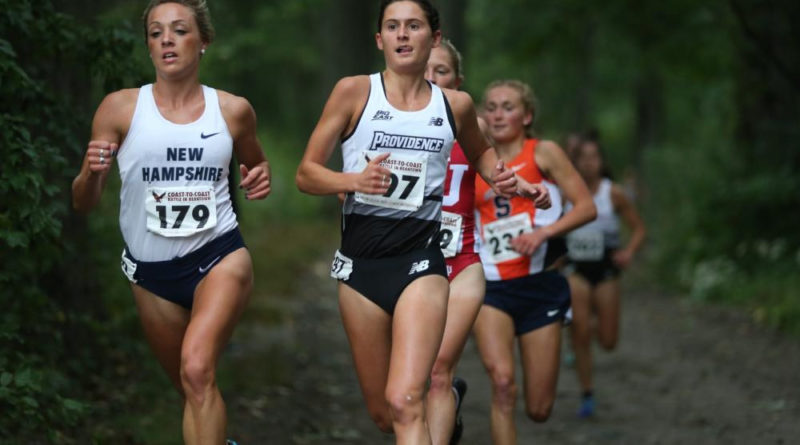How Elle Purrier-St. Pierre Picked Up Her Pace
By Timothy J. Moore
On Feb. 13, 2021, at the New Balance Indoor Grand Prix, middle distance elite runner Elle Purrier-St. Pierre, 26, smashed the American 2-mile record, bettering Jenny Simpson’s outdoor record by 8 seconds. Purrier clocked 9:10.28 — indoors (running 4:42 and 4:28 splits with a 63-second last 400). A year ago, she ran a 4:16.85 indoor mile at the Millrose Games NYRR Wanamaker Mile, shattering the meet and American record, as well as breaking Mary Decker’s legendary 37-year-old mark. At the Olympic Trials, she posted a record-breaking time for that 1,500-meter track event, 3:58. Just behind her were New Balance teammates Cory McGee and Heather Maclean. Both MacLean, who is from Peabody, Ma., and Purrier-St. Pierre are coached by Mark Coogan. [For more on Elle, see Elle Purrier-St. Pierre’s Meteoric Rise]
Coogan credits much of Elle’s success to the training that has made her into an “aerobic animal.” Coogan is an Olympic Marathoner with incredible range. He is the first sub 4-minute miler in the state of Massachusetts to also complete a 2:13 marathon PR. The former head coach at Dartmouth where he guided the career of multi NCAA Champion and Rio Games competitor Abbey D’Agostino, he is now the head of the elite New Balance team in Boston.
We spoke with the coach and athlete to get the details on what Elle’s training entails and how you too can build power.
Mark Coogan’s Workout Tips
“When runners think about improving aerobic power they tend to rely on the old standby of pumping up their weekly mileage. But there is definitely more to running fast than mega miles if you want to activate your inner beast mode as an endurance athlete,” Coogan says.
Coogan has kept Elle’s weekly mileage at a level of “high 60’s to low 70’s depending on the time of year.” That’s because research shows there does not seem to be any significant increase in VO2 max when running more than 75 to 80 miles per week. Coogan’s practical approach to training continues the theme that Elle’s college coach followed where she started off her freshman year running around 30 mile weeks. That rational philosophy in turn has given Elle massive room to grow as an athlete, and the chance to continue to mature as a runner throughout her career. With that goal in mind, Elle has gradually increased her mileage 10 miles per week each year, according to Coogan’s structured plan.
When adding volume, Coogan recommends using some creativity, such as adding more time to your warm up and cool down, and doubling up on runs during the week.
Elle’s lower training volume allowed her to perform high intensity workouts every week, which research shows are key to improving VO2 max and lactate threshold, indicators of aerobic power that are critical for sustained fast running. To help lay a strong aerobic foundation for Elle, Coogan based her training scheme around three main workouts each week: “A tempo workout at threshold pace on Tuesday, a hard interval session Friday, and a long run Sunday.” Here are some details on each of these workouts as Elle does them, and some advice on running them yourself.

Tempo Runs
Elle’s favorite go-to session for pumping up her aerobic power is a long tempo run. “Tempo runs for Elle are usually between 20 and 30 minutes depending on the goal of the workout,” Coogan says. “Tempo work is usually done at 1/2 marathon type pace or a little faster, and we often do 1 minute efforts after tempo work.”
Lactate Threshold Tempo: Start off by running a two-mile warm up, with the initial pace being on the conservative side of your goal range. Followed by a continuous run of between 20 to 30 minutes at a strong smooth rhythm. Although, if you are finding it hard to get moving, you might want to add in a quick 45-second surge toward the end of your warm-up to get the aerobic juices flowing. Finish with a comfortable two mile cool down.
Progressive Surge Tempo: Using a similar format to the Lactate Threshold Tempo, start off with a comfortably quick rhythm and then gradually increase the intensity until you are running at a harder, more aggressive pace near the end of your workout. This type of Tempo is great for practicing how to stay as relaxed as possible as the pace quickens, an essential skill for any elite runner. Focus on the phrase “Fast is Relaxed.”
Pro Tip: During New Balance training sessions Coogan likes to teach his athletes how to use ‘perceived effort’ to help gauge the intensity of their tempo runs to produce the best possible results. Heart rate and mile per minute paces can fluctuate based on the time of year and shape of the athlete, sometimes holding back a runner’s workout from going past a pre-set limit.
Intervals
Coogan uses interval training with work periods of 3 to 5 minutes to improve Elle’s aerobic power, while giving her the unshakable confidence needed to produce optimal race efforts. As for pace and effort, Coogan says, “I base everything on how Elle is feeling and what type of shape she is in. You can’t be in 4:16 shape year round. So we do a lot of work at a 5K pace when on the track.”
Cruise Intervals One of Coogan’s favorite workouts for boosting aerobic power is a 5 x 1 mile (run in 5 minutes flat or, approximately, a 5K pace for Elle) with 3 minutes rest. “We do these intervals instead of Tempo/Threshold work, especially when the weather is intervening” says Coogan. “Elle will warm up about 3 miles and do form drills and strides before starting her workout. She then follows it up with a cool down of between 2 to 3 miles on most occasions.”
Pre-Meet Confidence Builder Displaying her massive aerobic capacity, Elle completed an out of this world workout on the track while training in Arizona ahead of her newly-minted American record in the 2-mile. “The workout was to show Elle she could run the American record,” Coogan says. “It was to help her believe in herself. But we did not peak or taper at all, we just did our normal preparation for the meet.” Her “confidence builder” workout consisted of: One mile in 4:30, then a 4 x 400 in 65 seconds with three minutes rest; then one mile in 4:30.
Pro Tip: Coogan says his job also revolves around leveling out the extreme highs and lows that many other athletes experience. One of the ways he helps accomplish this goal is by “limiting the number of A+ performances in practice. I want my athletes to run B+ efforts in workouts, so we’re ready to go for the major events, like the Olympic Trials.” Whether it’s a 5K or marathon, don’t leave your best efforts in training.
Long Runs
Coogan’s New Balance runners put in weekly 12 to 16 mile easy long runs to improve the body’s glycogen storage capacity, as well as produce the endurance-boosting cardiovascular adaptations that come from extended efforts. The long runs also help train the mind to be better able to focus over long periods, while tuning the efficiency of a runner’s form.
“We usually just do our long runs at conversational pace,” Coogan says. “Maybe the last couple of miles they pick it up. I look at it as time on their feet, not getting too caught up in the mileage. For the most part I try to keep long runs fun and enjoyable — you need that type of environment to be successful.”
Pro Tip: While in Boulder training for the 1996 Olympic Marathon, Coogan says he would do “A two-and-a-half hour run in the morning, and follow it up with a medium run in the afternoon for close to 30 miles in a 24 hour period.” He would also perform his intervals on Friday, and then do his long run the next day, in a technique popularized by two-time Olympic marathoner Pete Pfitzinger. Using this “stacking” format will not only help you tap into muscle fibers that you might not normally use, but also push your body to the depths of glycogen depletion in an effort to build up stamina and endurance.
Ultimately Coogan stresses that the aerobic power workouts he creates for Elle are just one part of a comprehensive system that includes other important factors such as sound nutritional practices, effective recovery techniques, and critical cross training sessions like strength work designed to keep Elle healthy and injury free. “Consistency is one of the major keys to her outstanding performances,” Coogan says.
Timothy J. Moore, Ph.D., C.S.C.S., M.C.H.E.S., is a Former Division I athlete and coach at the University of Maryland who has trained top professional athletes, collegiate All-Americans, World Champion competitors and Team USA members in multiple sports. Moore has also served on the Personal Trainer Exam Committee for the American Council on Exercise, as the Fitness and Gear Editor for Shape magazine, as well as a consultant to the Kerlan-Jobe Orthopaedic Clinic.


Pingback: Elle Purrier-St. Pierre's Meteoric Rise - Vermont Sports Magazine
Pingback: Elle Purrier-St. Pierre's Run for the Finals - Vermont Sports Magazine